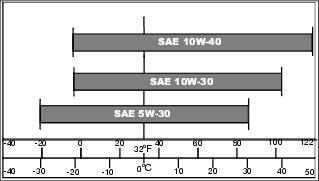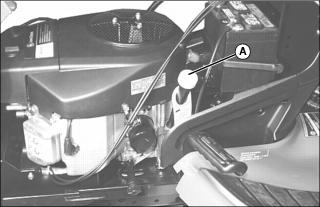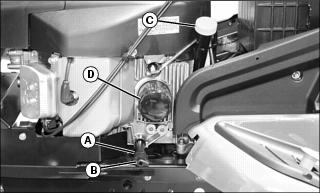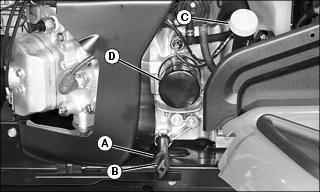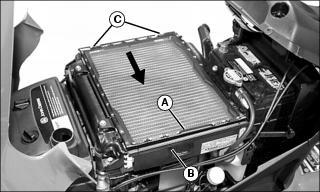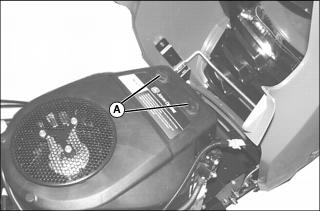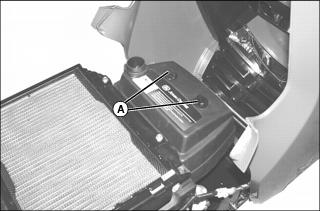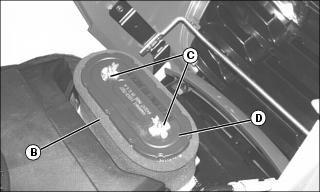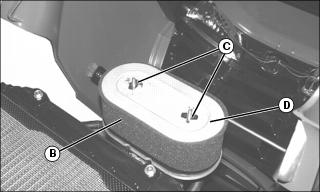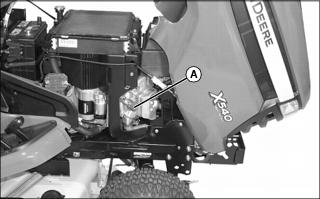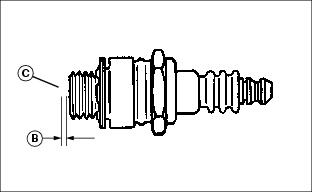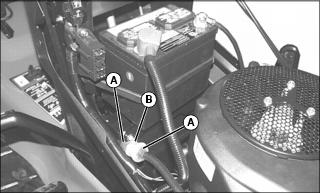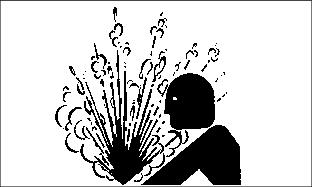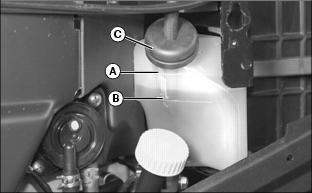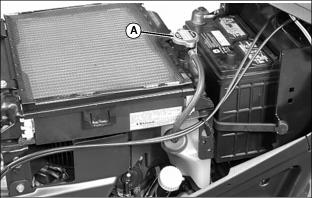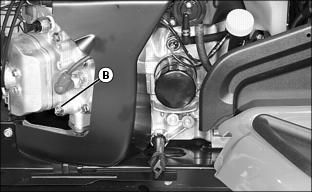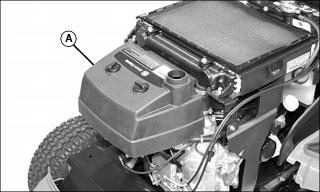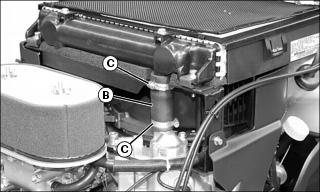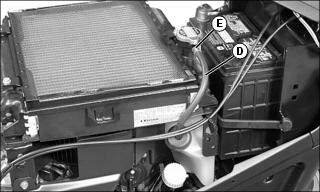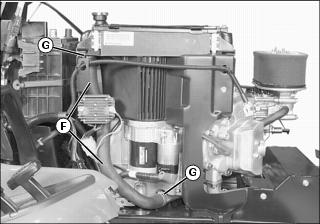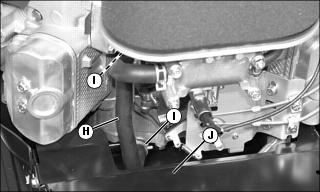
Service Engine
Engine Warranty Maintenance Statement
Maintenance, repair, or replacement of the emission control devices and systems on this engine, which are being done at the customer’s expense, may be performed by any non-road engine repair establishment or individual. Warranty repairs must be performed by an authorized John Deere dealer.
Avoid Fumes
Engine Oil
Use oil viscosity based on the expected air temperature range during the period between oil changes.
The following John Deere oils are preferred:
Other oils may be used if above John Deere oils are not available, provided they meet the following specification:
• API Service Classification SG or higher
Checking Engine Oil Level
NOTE: Check oil twice a day if you run engine over 4 hours in a day.
Make sure engine is cold when checking engine oil level.
1. Park machine safely. (See Parking Safely in the SAFETY section.)
3. Clean area around dipstick to prevent debris from falling into crankcase.
4. Remove dipstick (A). Wipe with clean cloth.
5. Install dipstick in tube but do not tighten. Allow dipstick threads to rest on top of tube and rotate cap counterclockwise until it “clicks” or drops into place.
7. Check oil level on dipstick. Oil must be between ADD and FULL marks.
8. If oil level is low, add oil to bring oil level no higher than FULL mark on dipstick. Do not overfill.
9. Install and tighten dipstick. Lower hood.
Changing Engine Oil and Filter
2. Park machine safely on level surface. (See Parking Safely in the SAFETY section.)
Picture Note: X500, X534 shown.
Picture Note: X520, X540 shown.
4. Put drain pan under drain valve (A).
5. Remove drain cap (B) and drain oil into drain pan. Allow oil to drain completely.
7. Wipe dirt from around oil filter (D).
8. Place a drain pan or funnel under oil filter tray.
9. Remove old filter and wipe off filter tray.
10. Put a light coat of fresh, clean oil on the new filter gasket.
11. Install replacement oil filter by turning oil filter to the right (clockwise) until the rubber gasket contacts filter base. Tighten filter an additional one-half turn.
12. Install and tighten drain cap (B).
13. Add oil no higher than FULL mark on dipstick. Do not overfill.
• X500 and X534: Begin with approximately 1.9 L (2.1 qt).
• X520 and X540 : Begin with approximately 2.3 L (2.4 qt).
15. Start and run engine at idle to check for leaks. Stop engine. Fix any leaks before operating.
16. Check oil level. Add oil if necessary.
Cleaning Air Intake/Radiator Screen and Cooling/Radiator Fins
• Clear work area of bystanders. • Wear eye protection when using compressed air for cleaning purposes. |
Air Cooled Engine (X500, X534)
1. Park machine safely. (See Parking Safely in the SAFETY section.)
3. Clean air intake screen on top of engine and external surfaces with rag, brush, vacuum or compressed air.
Liquid Cooled Engine (X520, X540)
1. Park machine safely. (See Parking Safely in the SAFETY section.)
3. Lift left edge of radiator screen (A) on top of radiator (B), and slide screen to the left to disengage from two retaining tabs (C) on right side of radiator.
4. Remove radiator screen and clean with compressed air, vacuum or brush. Cleaning with water is not recommended.
5. Check for dirt and insects lodged in radiator cooling fins. Clean with compressed air.
Checking and Cleaning Air Cleaner Elements
1. Park machine safely (See Parking Safely in the SAFETY section).
Picture Note: Air cooled model shown.
Picture Note: Liquid cooled model shown.
3. Loosen nuts (A) on both sides of air cleaner cover and remove cover.
Picture Note: Air cooled model shown.
Picture Note: Liquid cooled model shown.
4. Inspect the foam precleaner (B) without removing it.
5. If the foam precleaner is dirty:
• Remove the filter carefully.
• Wash precleaner in a solution of warm water and liquid detergent.
NOTE: Do not put engine oil on precleaner. Engine oil on precleaner can result in poor engine performance.
• Rinse precleaner thoroughly. Squeeze out excess water in a dry cloth until precleaner is completely dry.
6. Remove foam precleaner (B), wing nuts (C), and paper element (D). Inspect paper element.
7. If the paper filter element is damaged or dirty, replace filter.
8. Clean air cleaner base very carefully, preventing any dirt from falling into carburetor.
9. Install foam precleaner (B) onto paper filter element (D). Install paper element onto carburetor base, and secure with two wing nuts (C). Install air cleaner cover and tighten nuts (A).
Checking Spark Plug
1. Park machine safely (See Parking Safely in the SAFETY section).
3. Disconnect spark plug wire (A), one on each side of engine.
5. Clean spark plug carefully with a wire brush.
• Pitted or damaged electrodes.
NOTE: In Canada, replace spark plug with resistor plug only.
7. Replace spark plugs as necessary.
8. Check plug gap (B) with a wire feeler gauge. To change gap, move the outer electrode. Gap must be 0.75 mm (0.030 in.).
• X500 and X534 -Tighten spark plugs to 15 N•m (11 lb-ft.).
• X520 and X540 -Tighten spark plugs to 25 N•m (18 lb-ft).
10. Connect spark plug wires and lower hood.
Adjusting Carburetor
NOTE: Carburetor is calibrated by the engine manufacturer and is not adjustable.
If engine is operated at altitudes above 1006 m (3,300 ft), some carburetors may require a special high altitude main jet. See your authorized dealer.
If engine is hard to start or runs rough, check the TROUBLESHOOTING section of this manual.
Possible engine surging will occur at high throttle with transmission in “N” neutral and mower engagement lever disengaged. This is a normal condition due to the emission control system.
After performing the checks in the troubleshooting section and your engine is still not performing correctly, contact your authorized dealer.
Replacing Fuel Filter
NOTE: Change filter when fuel is low.
1. Park machine safely. (See Parking Safely in the SAFETY section).
4. Put a drain pan under fuel filter.
5. Slide hose clamps (A) away from fuel filter (B) using pliers.
6. Disconnect hoses from filter.
7. Connect hoses to new filter making sure the filter arrow is pointing in the direction of the fuel flow.
8. Install clamps and check for leaks.
Service Cooling System Safely
Recommended Engine Coolant
The following John Deere coolants are preferred:
• COOL-GARD® PRE-DILUTED SUMMER COOLANT (TY16036).
• COOL-GARD® CONCENTRATED SUMMER COOLANT (TY16034).
If neither of the recommended coolants is available, use a glycol base coolant that meets the following specification:
Check container label before using to be sure it has the appropriate specifications for your machine. Use coolant with conditioner or add conditioner to coolant before using.
If using concentrate, mix approximately 50 percent antifreeze with 50 percent distilled or deionized water before adding to cooling system. This mixture will provide freeze protection to -37 degrees C (-34 degrees F).
Certain geographical areas may require lower temperature protection. See the label on your antifreeze container or consult your John Deere dealer to obtain the latest information and recommendations. Never exceed the maximum dilution rate for the coolant you are using. Exceeding the maximum rate will greatly reduce the coolant effectiveness.
Servicing Cooling System (X520, X540)
Checking Coolant Level
1. Park machine safely on a level surface. (See Parking Safely in the SAFETY section.)
NOTE: Graphic shows the coolant level marks at the front side of the coolant recovery tank. Another set of coolant level marks is visible at the rear of the recovery tank, in front of the battery.
• If engine is hot, coolant should be up to “H” mark (A) on recovery tank.
• If engine is cold, coolant should be at “L” mark (B) on recovery tank.
4. Remove cap (C) from recovery tank if coolant is low. Add ethylene glycol antifreeze (without stop-leak additive) and water in a 50/50 ratio to bring coolant up to proper level.
5. Install and tighten recovery tank cap.
6. Clean debris from air intake screens and radiator.
7. Check condition of hoses. Check for leaks or loose connections.
Draining Cooling System
1. Park machine safely on a level surface. (See Parking Safely in the SAFETY section.)
4. Loosen and remove radiator cap (A) slowly to release all pressure.
NOTE: Removal of the cylinder head drain plug (B) will allow most of the coolant to be drained from the engine. Removal of the radiator hose at the water pump inlet will allow additional coolant to be drained, if necessary.
5. Place a suitable container under the drain plug (B) at the left cylinder head, remove drain plug and drain coolant.
6. Install drain plug after coolant has drained completely.
7. Install radiator cap, or flush the cooling system, if necessary.
Flushing Cooling System
2. Fill cooling system with clean water and John Deere Cooling System Cleaner, or John Deere Cooling System Quick Flush or an equivalent. Follow directions on the can.
3. Install and tighten radiator cap.
4. Start and run engine until it reaches operating temperature.
6. Drain cooling system immediately before rust and dirt settle.
Filling Cooling System
3. Fill cooling system. Coolant capacity is 3.0 L (3.2 qt), including the recovery tank.
4. Install and tighten radiator cap.
5. Run engine until it reaches operating temperature.
7. Check coolant level while engine is hot and after cooling to ensure proper level in recovery tank. If necessary, fill recovery tank to proper level.
8. Tighten hose clamps if necessary.
Checking Coolant Hoses (X520, X540)
NOTE: Visually inspect hoses for cracks and wear. Squeeze hoses to check for deterioration. Hoses should not be hard and brittle, nor soft or swollen. Drain cooling system and replace hoses as needed. Replacement of the coolant overflow line does not require draining the system.
1. Park machine safely. (See Parking Safely in the SAFETY section.)
4. Remove air cleaner cover (A).
5. Check front radiator hose (B), that goes to thermostat housing. Replace as needed. Check tightness of clamps (C).
6. Check coolant overflow hose (D) at left side of engine. Replace as needed. Check condition of clamp (E).
7. Check radiator hose (F), at right side of engine, that goes to the water pump inlet. Replace as needed. Check tightness of clamps (G).
8. Check coolant hose (H) between water pump and intake manifold at front of engine. Replace as needed. Check condition of clamps (I). Removal of muffler cover (J) will improve access for hose replacement.
